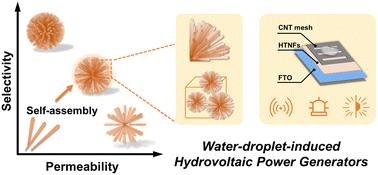当前位置:
X-MOL 学术
›
Energy Environ. Sci.
›
论文详情
Our official English website, www.x-mol.net, welcomes your feedback! (Note: you will need to create a separate account there.)
3D dendritic hierarchically gradient nanoflowers in situ grown on conductive substrates for efficient hydrovoltaic power generation
Energy & Environmental Science ( IF 32.4 ) Pub Date : 2024-06-11 , DOI: 10.1039/d4ee00828f Yanan Wang 1, 2 , Xianrong Yuan 1, 2 , Kun Ni 2, 3 , Yuhang Song 1, 2 , Xiang Li 1, 2 , Xuelian Zeng 1, 2 , Beibei Shao 1, 2 , Baoquan Sun 1, 2, 4
Energy & Environmental Science ( IF 32.4 ) Pub Date : 2024-06-11 , DOI: 10.1039/d4ee00828f Yanan Wang 1, 2 , Xianrong Yuan 1, 2 , Kun Ni 2, 3 , Yuhang Song 1, 2 , Xiang Li 1, 2 , Xuelian Zeng 1, 2 , Beibei Shao 1, 2 , Baoquan Sun 1, 2, 4
Affiliation

|
Hydrovoltaic power generators (HPGs) that continuously produce electricity through the interactions between water molecules and surface-charged pores/channels constitute a promising sustainable power generation strategy. However, current hydrovoltaic materials are hindered by inadequate power generation due to the selectivity–permeability trade-offs and the unclear structure–activity relationships between the pore/channel structure and the resulting electrical performance. In this study, an efficient water-droplet-induced HPG was developed using three-dimensional dendritic hierarchically graded nanoflowers grown in situ on the bottom electrode. The nanoflowers formed by the self-assembly of nanocells composed of nanorods featured an increased surface area and hierarchical macro/meso/microporosities that achieved synergistic high ionic selectivity and permeability. The in situ preparation of nanoflowers also facilitated their robust contact with the bottom electrode. Consequently, a single water droplet (20 μL) produced an open-circuit voltage of 600 mV and a high short-circuit current density of 45 μA cm−2, approximately twice that of other hydrovoltaic materials. By leveraging the tunable porous structure with a precisely controlled average pore size spanning a broad range (20 nm–3.77 μm), the intricate correlation between the pore structure and the device performance was elucidated. Multifunctional self-powered sensing platforms, including an intelligent ultraviolet light alarm, a wearable breath-monitoring mask, and a non-contact human–machine interface were demonstrated. The proposed hierarchical-gradient nanoflower structure provides a new paradigm for constructing high-performance hydrovoltaic materials.
中文翻译:

在导电基底上原位生长的 3D 树枝状分层梯度纳米花,用于高效水力发电
水力发电机(HPG)通过水分子和表面带电孔隙/通道之间的相互作用持续发电,构成了一种有前景的可持续发电策略。然而,由于选择性-渗透性权衡以及孔/通道结构与电性能之间不明确的结构-活性关系,目前的水力发电材料受到发电不足的阻碍。在这项研究中,利用在底部电极上原位生长的三维树枝状分级纳米花开发了一种高效的水滴诱导 HPG。由纳米棒组成的纳米细胞自组装形成的纳米花具有增加的表面积和分级的宏观/介观/微观孔隙度,实现了协同的高离子选择性和渗透性。纳米花的原位制备也促进了它们与底部电极的牢固接触。因此,单个水滴(20 μL)产生 600 mV 的开路电压和 45 μA cm −2 的高短路电流密度,大约是其他水电材料的两倍。通过利用具有广泛范围(20 nm-3.77 μm)的精确控制平均孔径的可调多孔结构,阐明了孔隙结构与器件性能之间复杂的相关性。展示了多功能自供电传感平台,包括智能紫外线报警器、可穿戴呼吸监测面罩和非接触式人机界面。所提出的分级梯度纳米花结构为构建高性能水电材料提供了新的范例。
更新日期:2024-06-11
中文翻译:

在导电基底上原位生长的 3D 树枝状分层梯度纳米花,用于高效水力发电
水力发电机(HPG)通过水分子和表面带电孔隙/通道之间的相互作用持续发电,构成了一种有前景的可持续发电策略。然而,由于选择性-渗透性权衡以及孔/通道结构与电性能之间不明确的结构-活性关系,目前的水力发电材料受到发电不足的阻碍。在这项研究中,利用在底部电极上原位生长的三维树枝状分级纳米花开发了一种高效的水滴诱导 HPG。由纳米棒组成的纳米细胞自组装形成的纳米花具有增加的表面积和分级的宏观/介观/微观孔隙度,实现了协同的高离子选择性和渗透性。纳米花的原位制备也促进了它们与底部电极的牢固接触。因此,单个水滴(20 μL)产生 600 mV 的开路电压和 45 μA cm −2 的高短路电流密度,大约是其他水电材料的两倍。通过利用具有广泛范围(20 nm-3.77 μm)的精确控制平均孔径的可调多孔结构,阐明了孔隙结构与器件性能之间复杂的相关性。展示了多功能自供电传感平台,包括智能紫外线报警器、可穿戴呼吸监测面罩和非接触式人机界面。所提出的分级梯度纳米花结构为构建高性能水电材料提供了新的范例。






































 京公网安备 11010802027423号
京公网安备 11010802027423号